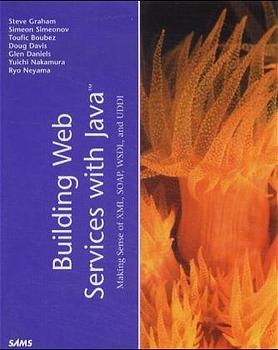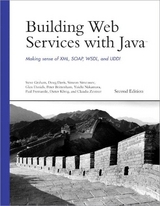
Building Web Services with Java
Sams Publishing (Verlag)
978-0-672-32181-8 (ISBN)
- Titel erscheint in neuer Auflage
- Artikel merken
Building Web Services with SOAP, XML, and UDDI assumes proficiency with Java and with distributed computing tools. Throughout the book, examples will be presented using Java and the Apache SOAP platform, although a set of sidebars will address .NET development, which Microsoft developers will use to deploy Web services. The book uses progressive disclosure to present an increasingly complex project as it moves through its development cycle. The final section of the book presents linking the completed project with other systems built in J2EE and .NET.
Steve Graham is an architect in the Emerging Technologies division of IBM Software Group. He has spent the last several years working on service-oriented architectures, most recently as part of the IBM Web Services Initiative. Prior to this, Steve worked as a technologist and consultant on various emerging technologies such as Java and XML, and before that he was an architect and consultant with the IBM Smalltalk consulting organization. Before joining IBM, Steve was a developer with Sybase, a consultant, and a faculty member in the Department of Computer Science at the University of Waterloo. Steve holds a BMath and MMAth in computer science from the University of Waterloo. You can reach him at sggraham@us.ibm.com. Simeon (Sim) Simeonov has been developing software for more than 15 years. Sim's areas of expertise encompass object-oriented technology, compiler theory, Internet tools, enterprise computing, and the broad spectrum of XML technologies. As chief architect at Macromedia Inc., Sim provides direction for the evolution of the company's technology and product strategy as well as the architecture of its server-side platform products. Previously, Sim was chief architect at Allaire Corporation, where his initiatives brought about numerous innovations to the core product lines. Sim is currently working on service-oriented architectures for the next generation of distributed XInternet applications. He is actively involved with the Java Community Process in the areas of Internet applications, XML, and Web Services. Sim also represents Macromedia on the W3C working group on XML Protocol. He is a regular speaker at conferences and a monthly columnist for XML Journal. Sim holds a B.A. in Computer Science, Economics, and Mathematics and a MSc in Computer Science. Toufic Boubez is the chief technology officer of Saffron Technology. Prior to joining Saffron, he was a senior technologist in IBM's Emerging Technologies group, and lead architect of IBM's Web services initiative. He was IBM's technical representative to the UDDI Web Services Consortium with Microsoft and Ariba and co-authored the UDDI API specification. He was also the IBM technical lead on the UN/CEFACT/OASIS ebXML initiative and helped drive IBM's early XML and Web services strategies. Dr. Boubez has more than 15 years of experience in IT and has published and presented on Web services, XML, object technology, distributed computing, intelligent agents, B2B, business modeling, simulation, neural networks, and wavelet analysis. He holds a doctorate in Biomedical Engineering from Rutgers University. Doug Davis works in the Emerging Technology organization of IBM, working on IBM's Web Services Toolkit, and he is one of IBM's representatives in the W3C XML Protocol working group. Previous projects include WebSphere's Machine Translation project, TeamConnection, and IBM's FORTRAN 90 compiler. Doug has a Bachelor of Science degree from the University of California at Davis and a Master's degree in Computer Science from Michigan State University. Glen Daniels, in his 13 years in the software industry, has run the gamut from device drivers and network stacks up through user interface and Web site work, in everything from assembly language to C++ to Lisp. Distributed computing has always been a passion, and as such he is currently technical lead for the JRun Web Services team at Macromedia. Glen is an active member of the W3C XML Protocol group as well as one of the lead developers of Axis. When not coding, he can often be found playing bass or harmonica, hanging out with his many crazy friends in the Boston area, or relaxing with his cats. Yuichi Nakamura is an advisory researcher at the IBM Tokyo Research Laboratory. His research interests are Web services including SOAP and XML security, object-oriented systems, J2EE, multiagent systems, B2B e-commerce, and knowledge engineering. He received an MSc and a PhD in Applied Physics from Osaka University in 1987 and 1990, respectively. Ryo Neyama is a researcher at the IBM Tokyo Research Laboratory. His research interests are distributed object systems including Web services, object request brokers, and security. He received an MSc in Information and Computer Science from Waseda University in 1999.
Introduction.
1. Web Services Overview.
What Is a Web Service? The Web Service Opportunity. Trends in e-business. Why Do We Need a Web Services Approach? Service-Oriented Architectures. Web Services Interoperability Stacks. Summary.
2. XML Primer.
Origins of XML. Document- Versus Data-Centric XML. XML Instances. XML Namespaces. Document Type Definitions. XML Schemas. Processing XML. Summary. Resources.
3. Simple Object Access Protocol (SOAP).
Evolution of XML Protocols. Simple Object Access Protocol (SOAP). Doing Business with SkatesTown. Inventory Check Web Service. SOAP Envelope Framework. Taking Advantage of SOAP Extensibility. SOAP Intermediaries. Error Handling in SOAP. SOAP Data Encoding. Architecting Distributed Systems with Web Services. Purchase Order Submission Web Service. SOAP Protocol Bindings. Summary. The Road Ahead. Resources.
4. Creating Web Services.
Why and What Is Axis? The Axis Architecture. Installing Axis. Configuring Axis. Security. Simple Web Services. Client-Side Programming. Advanced Web Service Deployment. Document-Centric Services. Data Encoding/Decoding. Building Handlers. Specialized Pivot Point Handlers, a.k.a. Providers. Faults. Message Patterns. Building and Deploying an Intermediary. SOAP V1.2. Monitoring. Summary.
5. Using SOAP for e-Business.
Web Services Security. Enterprise Application Integration. Quality of Service. Summary. Resources.
6. Describing Web Services.
Why Service Descriptions? Role of Service Description in a Service-Oriented _Architecture. Well Defined Service. History of IDLs. Web Services Definition Language (WSDL). WSDL and Java. Future Service Description Efforts. Summary.
7. Discovering Web Services.
The Role of Service Discovery. The Role of Registries. UDDI. Private UDDI Registries. What's New in UDDI Version 2.0? Using WSDL with UDDI. Summary.
8. Interoperability, Tools, and Middleware Products.
Interoperability: The “Holy Grail” of Web Services. The Larger Web Services Landscape. Summary. Resources.
Future Concepts.
Computing as a Utility. Ontologies and the Semantic Web. Software Agents. Peer-to-Peer Computing. Grid Computing. Embedded Web Services. Pulling It All Together. Resources.
Glossary.
Index.
| Erscheint lt. Verlag | 21.12.2001 |
|---|---|
| Verlagsort | Indianapolis |
| Sprache | englisch |
| Gewicht | 989 g |
| Themenwelt | Informatik ► Programmiersprachen / -werkzeuge ► Java |
| Mathematik / Informatik ► Informatik ► Web / Internet | |
| ISBN-10 | 0-672-32181-5 / 0672321815 |
| ISBN-13 | 978-0-672-32181-8 / 9780672321818 |
| Zustand | Neuware |
| Haben Sie eine Frage zum Produkt? |
aus dem Bereich



